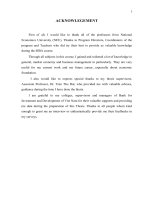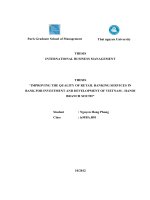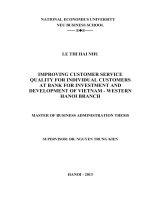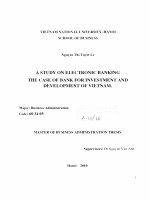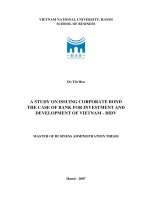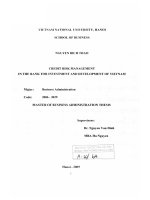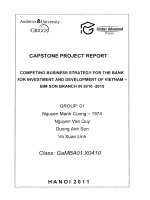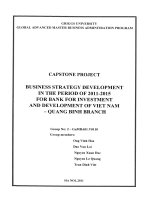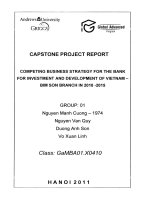improving payment card service on point of sale (pos) in bank for investment and development of viet nam
Bạn đang xem bản rút gọn của tài liệu. Xem và tải ngay bản đầy đủ của tài liệu tại đây (745.52 KB, 90 trang )
ACKNOWLEGEMENT
First of all, I would like to thank all of the professors from National
Economics University (NEU). Thanks to Program Directors, Coordinators of the
program and Teachers who did try their best to provide us valuable knowledge
during the MBA course.
Through all subjects in this course, I gained and widened a lot of knowledge in
general, market economy and business management in particularly. They are very
useful for my current work and my future career, especially about economic
foundation.
I also would like to express special thanks to my thesis supervisors,
Associate Professor, Dr. Tran Tho Dat, who provided me with valuable advises,
guidance during the time I have done the thesis.
I am grateful to my colleges, supervisors and managers of Bank for
Investment and Development of Viet Nam for their valuable supports and providing
me data during the preparation of this Thesis. Thanks to all people whom kind
enough to grant me an interview or enthusiastically provide me their feedbacks in
my surveys.
1
TABLE OF CONTENTS
CHAPTER 1 17
INTRODUCTION 17
1.1. Rationale 17
1.2. Research objectives 18
1.3. Research questions 18
1.4. Research methodology 18
1.4.1. Research process 18
1.4.2. Data collection method 19
Secondary data: Secondary data collected via internal source of BIDV.
They were collected mainly base on BIDV’s report, regulations and
official documents of BIDV, internet and newspapers within 4 years from
2007 to 2010 and used as the data for a desk research. Secondary data is
use to analyze the current situation of payment card service on POS in
BIDV 19
Primary data: Qualitative and quantitative methods were collected to get
the information. Qualitative data is collected through in-depth interview
with very important person (VIP) and managers. This data helps
researcher to understand clearly about their needs and expectations when
they make payment by card. Moreover, the researcher would like to know
about their point of view when they use BIDV payment card service, find
out their expectations. 19
1.4.3. Analyzing data 20
1.5. Research scope 21
1.6. Research structure 21
CHAPTER 2 22
THEORETICAL BACKGROUND 22
ON CARD AND PAYMENT CARD ON POS 22
2.1. History and development of ATM card and payment card on POS 22
2.2. Definition, classification, feature and transaction processing 24
2.2.1. Definitions 24
2.2.2. Classification type of transactions on POS 25
2.2.3. Feature and transaction processing 26
2
2.3. Member taking part in payment card on POS 26
2.4. Payment card on POS general framework 27
28
Source: Report on Brazilian card industry 28
2.5. Role and benefit of cards and payment card on POS 28
2.5.1. Benefit of card and payment card to the economy 28
2.5.2. Benefit of cards and payment card on POS to customers 29
2.5.3. Benefit of cards and payment card on POS to merchants 29
2.6. Factors affecting to payment card service on POS 30
2.6.1. Habit of using cash in the economy 30
2.6.2. The guidelines and policies government for payment card service on POS
31
2.6.3. The development of science technology 31
2.6.4. The infrastructures for using payment card 32
2.7. Rules for a good payment card service on POS 32
2.7.1. Security service 32
2.7.2. Convenient service 33
2.7.3. Speed processing: 33
2.8. Activities of Payment card service on POS 33
CURRENT SITUATION OF PAYMENT CARD SERVICE ON POS IN
BANK FOR INVESTMENT AND DEVELOPMENT OF VIETNAM 36
3.1. Introduction of BIDV 36
3.1.1. General information of BIDV 36
3.1.2. Fields of operation 36
3.1.3. Human Resources and Network: 36
3.1.4. Customers: 37
3.1.5. Technology: 37
3.1.6. Commitment: 38
3.1.7. Business reputation of BIDV: 38
3.2. Overview of payment card services 39
3.2.1. Overview of payment card service on POS in Viet Nam 39
3.2.2. Overview of payment card service in BIDV 40
3.3. Current situation of payment card service on POS in BIDV 42
3.3.1. Type of card accepted at BIDV POS 42
3.3.2. Function 42
3
3.3.3. Type of fee and ratio fee 42
3.3.4. Criterion to become BIDV merchant 43
3.3.5. Process to establish a merchant 45
3.3.6. Process of payment card 46
3.4. Evaluation of current BIDV POS services 49
3.4.1. Evaluation of transactions on BIDV POS 50
3.4.2. Evaluation of BIDV POS terminal 52
3.4.3. Evaluation of BIDV merchants 54
3.4.4. Evaluation of solving problem 56
3.4.5. Evaluation of customer’s satisfactions 57
3.4.6. Evaluation of revenue and fee on POS 58
3.5. Gap between current POS services and required services. 62
3.6. Limitations and reasons 64
3.6.1. Limitation 64
3.6.2. Reasons 65
CHAPTER 4 66
SOLUTIONS TO IMPROVE PAYMENT 66
CARD SERVICE ON POS IN BIDV 66
4.1. Solutions for marketing of card and payment card 66
4.1.1. Promoting advertisement of card and payment card 66
4.1.2. Identifying market segment and targets 67
4.1.3. Build brand name of BIDV 68
4.2.2. Having a suitable promotion and customer care program 69
4.3. Increasing investment for technical equipment and system for payment 70
4.3.1. Investing and developing technology on POS services 70
4.4. Pay attention to develop human resource 70
4.4.1. Reorganize Card department at branch more suitable 70
4.4.2. Developing human resources for card services 71
4.5. Enhance utility of card and POS services 71
4.5.1. Enhance research activities and develop card product 71
4.5.2. Connect between other banks and financial organization 72
4.6. Solutions for preventing and manager risk on payment card 72
4.6.1. Enhance risk management activities and prevent risk 72
4.6.2 Make a choice reputable merchant 74
4.6.3. Limit the risk of payment card service on POS 74
4
CONCLUSION 76
5
ABBREVIATIONS
ATM: Automatic Teller Machine
BIDV: Bank for Investment and Development of Vietnam
EDC: Electronic data capture
HR: Human resource
MOTO: Mail order/ Telephone Order
POS: Point of Sale
PIN: Personal identification number
VCB: Joint stock commercial bank for foreign trade of Viet Nam
6
LIST OF TABLES
CHAPTER 1
INTRODUCTION
1.1. Rationale 17
1.2. Research objectives 18
1.3. Research questions 18
1.4. Research methodology 18
1.4.1. Research process 18
1.4.2. Data collection method 19
Secondary data: Secondary data collected via internal source of BIDV.
They were collected mainly base on BIDV’s report, regulations and
official documents of BIDV, internet and newspapers within 4 years from
2007 to 2010 and used as the data for a desk research. Secondary data is
use to analyze the current situation of payment card service on POS in
BIDV
Primary data: Qualitative and quantitative methods were collected to get
the information. Qualitative data is collected through in-depth interview
with very important person (VIP) and managers. This data helps
researcher to understand clearly about their needs and expectations when
they make payment by card. Moreover, the researcher would like to know
about their point of view when they use BIDV payment card service, find
out their expectations
1.4.3. Analyzing data 20
1.5. Research scope 21
1.6. Research structure 21
CHAPTER 2
THEORETICAL BACKGROUND
ON CARD AND PAYMENT CARD ON POS
2.1. History and development of ATM card and payment card on POS 22
2.2. Definition, classification, feature and transaction processing 24
2.2.1. Definitions 24
2.2.2. Classification type of transactions on POS 25
2.2.3. Feature and transaction processing 26
7
2.3. Member taking part in payment card on POS 26
2.4. Payment card on POS general framework 27
28
Source: Report on Brazilian card industry 28
2.5. Role and benefit of cards and payment card on POS 28
2.5.1. Benefit of card and payment card to the economy 28
2.5.2. Benefit of cards and payment card on POS to customers 29
2.5.3. Benefit of cards and payment card on POS to merchants 29
2.6. Factors affecting to payment card service on POS 30
2.6.1. Habit of using cash in the economy 30
2.6.2. The guidelines and policies government for payment card service on POS
31
2.6.3. The development of science technology 31
2.6.4. The infrastructures for using payment card 32
2.7. Rules for a good payment card service on POS 32
2.7.1. Security service 32
2.7.2. Convenient service 33
2.7.3. Speed processing: 33
2.8. Activities of Payment card service on POS 33
CURRENT SITUATION OF PAYMENT CARD SERVICE ON POS IN
BANK FOR INVESTMENT AND DEVELOPMENT OF VIETNAM
3.1. Introduction of BIDV 36
3.1.1. General information of BIDV 36
3.1.2. Fields of operation 36
3.1.3. Human Resources and Network: 36
3.1.4. Customers: 37
3.1.5. Technology: 37
3.1.6. Commitment: 38
3.1.7. Business reputation of BIDV: 38
3.2. Overview of payment card services 39
3.2.1. Overview of payment card service on POS in Viet Nam 39
3.2.2. Overview of payment card service in BIDV 40
3.3. Current situation of payment card service on POS in BIDV 42
3.3.1. Type of card accepted at BIDV POS 42
3.3.2. Function 42
8
3.3.3. Type of fee and ratio fee 42
3.3.4. Criterion to become BIDV merchant 43
3.3.5. Process to establish a merchant 45
3.3.6. Process of payment card 46
3.4. Evaluation of current BIDV POS services 49
3.4.1. Evaluation of transactions on BIDV POS 50
3.4.2. Evaluation of BIDV POS terminal 52
3.4.3. Evaluation of BIDV merchants 54
3.4.4. Evaluation of solving problem 56
3.4.5. Evaluation of customer’s satisfactions 57
3.4.6. Evaluation of revenue and fee on POS 58
3.5. Gap between current POS services and required services 62
3.6. Limitations and reasons 64
3.6.1. Limitation 64
3.6.2. Reasons 65
CHAPTER 4
CHAPTER 4
SOLUTIONS TO IMPROVE PAYMENT
SOLUTIONS TO IMPROVE PAYMENT
CARD SERVICE ON POS IN BIDV
CARD SERVICE ON POS IN BIDV
4.1. Solutions for marketing of card and payment card 66
4.1.1. Promoting advertisement of card and payment card 66
4.1.2. Identifying market segment and targets 67
4.1.3. Build brand name of BIDV 68
4.2.2. Having a suitable promotion and customer care program 69
4.3. Increasing investment for technical equipment and system for payment 70
4.3.1. Investing and developing technology on POS services 70
4.4. Pay attention to develop human resource 70
4.4.1. Reorganize Card department at branch more suitable 70
4.4.2. Developing human resources for card services 71
4.5. Enhance utility of card and POS services 71
4.5.1. Enhance research activities and develop card product 71
4.5.2. Connect between other banks and financial organization 72
9
4.6. Solutions for preventing and manager risk on payment card 72
4.6.1. Enhance risk management activities and prevent risk 72
4.6.2 Make a choice reputable merchant 74
4.6.3. Limit the risk of payment card service on POS 74
CONCLUSION
CONCLUSION
10
LIST OF FIGURES
CHAPTER 1
INTRODUCTION
1.1. Rationale 17
1.2. Research objectives 18
1.3. Research questions 18
1.4. Research methodology 18
1.4.1. Research process 18
1.4.2. Data collection method 19
Secondary data: Secondary data collected via internal source of BIDV.
They were collected mainly base on BIDV’s report, regulations and
official documents of BIDV, internet and newspapers within 4 years from
2007 to 2010 and used as the data for a desk research. Secondary data is
use to analyze the current situation of payment card service on POS in
BIDV
Primary data: Qualitative and quantitative methods were collected to get
the information. Qualitative data is collected through in-depth interview
with very important person (VIP) and managers. This data helps
researcher to understand clearly about their needs and expectations when
they make payment by card. Moreover, the researcher would like to know
about their point of view when they use BIDV payment card service, find
out their expectations
1.4.3. Analyzing data 20
1.5. Research scope 21
1.6. Research structure 21
CHAPTER 2
THEORETICAL BACKGROUND
ON CARD AND PAYMENT CARD ON POS
2.1. History and development of ATM card and payment card on POS 22
2.2. Definition, classification, feature and transaction processing 24
2.2.1. Definitions 24
2.2.2. Classification type of transactions on POS 25
11
2.2.3. Feature and transaction processing 26
2.3. Member taking part in payment card on POS 26
2.4. Payment card on POS general framework 27
28
Source: Report on Brazilian card industry 28
2.5. Role and benefit of cards and payment card on POS 28
2.5.1. Benefit of card and payment card to the economy 28
2.5.2. Benefit of cards and payment card on POS to customers 29
2.5.3. Benefit of cards and payment card on POS to merchants 29
2.6. Factors affecting to payment card service on POS 30
2.6.1. Habit of using cash in the economy 30
2.6.2. The guidelines and policies government for payment card service on POS
31
2.6.3. The development of science technology 31
2.6.4. The infrastructures for using payment card 32
2.7. Rules for a good payment card service on POS 32
2.7.1. Security service 32
2.7.2. Convenient service 33
2.7.3. Speed processing: 33
2.8. Activities of Payment card service on POS 33
CURRENT SITUATION OF PAYMENT CARD SERVICE ON POS IN
BANK FOR INVESTMENT AND DEVELOPMENT OF VIETNAM
3.1. Introduction of BIDV 36
3.1.1. General information of BIDV 36
3.1.2. Fields of operation 36
3.1.3. Human Resources and Network: 36
3.1.4. Customers: 37
3.1.5. Technology: 37
3.1.6. Commitment: 38
3.1.7. Business reputation of BIDV: 38
3.2. Overview of payment card services 39
3.2.1. Overview of payment card service on POS in Viet Nam 39
3.2.2. Overview of payment card service in BIDV 40
3.3. Current situation of payment card service on POS in BIDV 42
3.3.1. Type of card accepted at BIDV POS 42
12
3.3.2. Function 42
3.3.3. Type of fee and ratio fee 42
3.3.4. Criterion to become BIDV merchant 43
3.3.5. Process to establish a merchant 45
3.3.6. Process of payment card 46
3.4. Evaluation of current BIDV POS services 49
3.4.1. Evaluation of transactions on BIDV POS 50
3.4.2. Evaluation of BIDV POS terminal 52
3.4.3. Evaluation of BIDV merchants 54
3.4.4. Evaluation of solving problem 56
3.4.5. Evaluation of customer’s satisfactions 57
3.4.6. Evaluation of revenue and fee on POS 58
3.5. Gap between current POS services and required services 62
3.6. Limitations and reasons 64
3.6.1. Limitation 64
3.6.2. Reasons 65
CHAPTER 4
SOLUTIONS TO IMPROVE PAYMENT
CARD SERVICE ON POS IN BIDV
4.1. Solutions for marketing of card and payment card 66
4.1.1. Promoting advertisement of card and payment card 66
4.1.2. Identifying market segment and targets 67
4.1.3. Build brand name of BIDV 68
4.2.2. Having a suitable promotion and customer care program 69
4.3. Increasing investment for technical equipment and system for payment 70
4.3.1. Investing and developing technology on POS services 70
4.4. Pay attention to develop human resource 70
4.4.1. Reorganize Card department at branch more suitable 70
4.4.2. Developing human resources for card services 71
4.5. Enhance utility of card and POS services 71
4.5.1. Enhance research activities and develop card product 71
4.5.2. Connect between other banks and financial organization 72
4.6. Solutions for preventing and manager risk on payment card 72
4.6.1. Enhance risk management activities and prevent risk 72
4.6.2 Make a choice reputable merchant 74
13
4.6.3. Limit the risk of payment card service on POS 74
CONCLUSION
14
EXECUTIVE SUMMARY
The payment goods and services by card on POS is a convenient and
advance mean of payment and bring banks a lot of benefit from this service as well.
Understanding the advantage of the mean of payment, BIDV has invested and
developed this service since 2007. However, with the limited technology system
and lack of experiences, the development of this service in BIDV is much less than
other banks. More and more banks have concentrated on developing card services
including POS services and merchant network. On the other hand, retail banking
service including card services play an important role in banking activities. It is one
of a channel bring a lot of benefit to the banks and make a close image of the bank
with customers. For purpose of having a greater understanding of this issue, the
thesis is designed to answer following questions: Firstly, what are expectations of
merchants and customers of using card and card services? Secondly, what is current
situation of payment card service on POS in BIDV? Thirdly, is there any gap
between the current situation of payment card service on POS and the expectations
of merchants and customers? Fourthly, which solutions considered consistent to
expand merchant network in BIDV basing on the current conditions of the bank?
Finally, which solutions should be taken to improve payment card service on POS
in BIDV?
Base on literature foundation of card, payment card on POS, model of
payment card, the author would like to have a deeply understanding about this
services, analysis and synthesis primary data and secondary data to give out result,
limitation since then find out reasons. Primary data collected by in depth interviews
and questionnaire survey. Secondary data collected mostly from the bank policies,
regulations and reports.
I made surveys with 50 customers who have either BIDV card or the card of
other banks and have ever made payment on BIDV POS to get their expectations
when they make payment by card on POS and get their point of views about BIDV
POS service. I also made surveys with 30 BIDV merchants (include both managers
and cashiers) to get their expectations when they use BIDV POS services and get
15
their feedbacks of quality of BIDV POS services. The content of survey include
both questionnaire and evaluate by rate from 1 to 5 in which 1 is lowest and 5 are
highest. I analyzed data by excel application software. Moreover, I in dept
interviewed with 5 business customers and 5 managers at merchants to understand
deeply about their needs. The survey revealed some key finding as following:
BIDV payment card service on POS is not good enough in comparison with
customer’s expectation. Ratio of error transactions are still high and processing time
is still slow. BIDV POS terminal accepts not many types of cards. It is one of a
barrier to approach potential merchants.
Merchant networks have not been covered in the country yet. They are
located almost in big cities. There are few merchants which are located in rural
areas.
Procedures to establish a merchant is still slow and complicated. BIDV has
concentrated on customer care programs. However, it has not got a big result as
expectations. Some merchant still surcharge cardholder when they make payment
by card.
Majority of customers prefer paying cash to card because of their habits.
Most of people often uses mean of payment by card are businesses or the people
who have a high income or go abroad frequently. They find the convenience of the
mean of payment
Both cardholders and merchants would like to accept any types of card of
different banks at POS terminal. Transactions are processed speed and exact.
16
CHAPTER 1
INTRODUCTION
1.1. Rationale
Payment card on POS is very popular in many countries in the world. Buying
goods and services by card on POS has many advantages and brings customers
convenience and safety. However, it has not been a habit of Vietnamese people, yet.
One of reason why is that majority of Vietnamese often buy goods and services by
cash. Minority of Vietnamese use card as a means of payment (only the people who
have high income, often travel abroad or young generation) Moreover, the
infrastructure to support the payment cards on POS is still limited by the
technologies, quantities of merchants, etc… However, Viet Nam is a developing
country but we have joined the world trade organization and gradually integrated
and caught up with other countries. So, the payment card on POS might change and
become more popular and necessary to Vietnamese people if it has more support
from the government, other financial organizations, banks and means of media, etc.
In some recent years, several banks in Vietnam have concentrated on
developing card services and payment cards on POS. Bank for Investment and
Development of Viet Nam (BIDV) is one of the banks which pay attention to
developing card services and payment card service on POS. However, its quantities
and qualities of payment card service on POS in comparison with other banks are
less advanced. Types of card excepted at merchants are limited. Ratios of fail
transactions and fraud transactions are still high. Some commercial banks invest in
card services later than BIDV. However, they have invested better modern
technologies and taken experiences from previous banks. Therefore, they have
provided better card services, even better than BIDV or VCB which is considered to
be the leading banks in Viet Nam. Thus, developing and improving the payment
card service on POS to catch up with the development of the world, to meet the
needs of markets and customers are an important tasks for Vietnamese banks in
general and BIDV in particular. I, myself, have worked in BIDV Card center for
over 2 years. With the hope of performing a research relating to the payment card
17
service on POS in BIDV, I decide to follow this research topic “Improving payment
card service on Point of Sale (POS) in Bank for Investment and Development of
Viet Nam”.
1.2. Research objectives
In order to solve the research problem above, the thesis focused on clarifying
the objectives as below:
Exploring expectation of merchants and customers of using card and card
services.
Analyzing current payment card services on POS in BIDV.
Giving out solutions and suggestions to improve payment card service on
POS in BIDV.
1.3. Research questions
Related to this thesis, I will concentrate on answering some following questions:
What are expectations of merchants and customers of using card and card
services?
What is current situation of payment card service on POS in BIDV?
Is there any gap between the current situation of payment card service on
POS and the expectations of merchants and customers?
Which solutions are considered consistent to expand merchant network in
BIDV basing on the current conditions of the bank?
Which solutions should be taken to improve payment card service on POS in
BIDV?
1.4. Research methodology
1.4.1. Research process
The process of study of this thesis could be summed up in following chart:
18
CHART 1: THE PROCESS OF STUDY OF THESIS
Source: Author’s idea
1.4.2. Data collection method
Secondary data: Secondary data collected via internal source of BIDV.
They were collected mainly base on BIDV’s report, regulations and official
documents of BIDV, internet and newspapers within 4 years from 2007 to 2010 and
used as the data for a desk research. Secondary data is use to analyze the current
situation of payment card service on POS in BIDV
Primary data: Qualitative and quantitative methods were collected to get
the information. Qualitative data is collected through in-depth interview with very
important person (VIP) and managers. This data helps researcher to understand
clearly about their needs and expectations when they make payment by card.
19
Objectives of
payment card
service on POS
Payment card
service on POS
analysis
Interview with
customers,
manager, cashiers
at merchant
Questionnaires
Expectations
of merchants
and
customers
for payment
card
Current
situation
Of Payment
card service
on POS in
BIDV
GAPS
Solutions
Moreover, the researcher would like to know about their point of view when they
use BIDV payment card service, find out their expectations.
While quantitative data is collected through customer survey through Email,
telephone and meet in person.
I brief the method as follows:
Table 1.1: Data collection method
Data
collecting
method
Respondent/
interviewer
Number of
persons
Aim
In-depth
interview
Business
customers
5
To understand clearly
about the needs and
expectations when they
make payment by card.
Manager at
BIDV merchant
5
Exploring their view
when they use BIDV
payment card service,
find out their
expectations.
Survey
Customers who
have ever made
payment on
BIDV POS
50
Finding out their
expectation and trouble
of customers, when they
make payment by card.
According to their point
of view, finding out
weakness, strong,
advantages,
disadvantages of BIDV
payment card services
Managers of
merchant,
15
Cashier at
merchant who
swipe card in
person
15
Source: Author’s idea
1.4.3. Analyzing data
Basing on data collected to analyze current situation about payment card
service on POS in BIDV. Moreover, according to information from interview,
survey to find out expectation of customers and merchants in order orient and
suggest some solutions to develop payment card service on POS.
20
1.5. Research scope
With the aim to limit research scope, thesis is concentrated on analyzing and
evaluating in following scope:
Payment card service on POS objective: widen merchant network,
meet the need of customers, merchant and make them satisfy with
payment card and improve this service.
Scope of the research: Payment card service on point of sale (POS) at
BIDV merchant which is located in the north of Viet Nam.
Time period is chosen from 2007 – 2010
1.6. Research structure
Chapter one: Introduction
Chapter two: Theoretical background on card and payment card on POS
Chapter three: Current situation of payment card service on POS in BIDV
Chapter four: Solutions to improve payment card service on POS in BIDV
21
CHAPTER 2
THEORETICAL BACKGROUND
ON CARD AND PAYMENT CARD ON POS
In this chapter, the author presents key concepts and relevant theory
regarding card and payment card on POS. All theories are quoted from MasterCard
international organization and Visa international organization.
2.1. History and development of ATM card and payment card on POS
2.1.1. History and development of debit card
Debit cards are a new method to transact cash between a buyer and a seller of
goods or services. They replace the interest-bearing debt created by using credit
cards and restrict the user to the actual amount of money contained in his account.
When the card is used like an ATM card, or for online purchases, some banks and
credit unions charge fees.
The First National Bank of Seattle issued the first debit card to business
executives with large savings accounts in 1978. These cards acted like a check
signature or a guarantee card, where the bank promised the funds would cover the
transaction without the customer needing a check to complete the transaction. The
bank only issued debit cards to those customers who had a long history with the
bank and were in good standing, because like a check, the funds were not
immediately removed from the account. In 1984, Landmark implemented the first
nationwide debiting system, built on the credit card infrastructure and ATM
networks already in place. By 1998, debit cards outnumbered check usage around
the world. Its preference over checks continues to grow every year.
2.1.2. History and development of credit card
The credit card boom began in earnest in the 1960s, when bank-issued cards
from MasterCard and Visa became popular. By harnessing the electronic
transaction ability of large banks, MasterCard and Visa eclipsed the previously
dominate Diners Club, a company which processed transactions independently.
22
More access to processing systems mean that consumers could use cards at more
retailers and restaurants; the more establishments that accepted credit cards, the
more popular they became.
In the 1980s, American Express, which was originally marketed to
businesspeople, and Discover became market forces. Consumers could now choose
between bank- and store-issued cards, as well as independent credit card companies
like American Express and Discover.
China, India and South Korea provide the biggest opportunities for credit
card growth. As emerging economies, the capitalist public policies of these
countries and increased tourism mean credit card companies are gaining customers
overseas. Although growth is predicted to be somewhat slower in Latin America
and Eastern Europe, credit cards continue to penetrate these regions as well.
Simply, the more formerly socialist and communist countries turn to capitalist-
based economic systems, the more opportunity for credit card industry growth
worldwide.
In a 2008 U.S. Department of Commerce Report, Scott Schmith wrote that
growth in exports and the larger economy equates with growth for the credit card
and electronic payment industry. Therefore, as the global recession subsides, credit
card industry growth is expected. Yet the timing of that growth is debated. The
banking consultancy Tower Group predicts that moderate growth in the credit card
industry will not begin until 2011. This is due to the potential for stricter
government regulation of credit cards, as well as trends toward debit card spending
and high credit delinquency rates, Tower Group says.
2.1.3 History and development of ATM and POS systems
Barclays Bank in the United Kingdom developed and installed the first
automatic teller machine (ATM) in 1967. However, it did not resemble the one as
today. Customers weren’t given a plastic card instead they received paper vouchers
that had a value of 10. The customer would insert the voucher into the machine in
exchange for a 10 pound note.
23
In 1969, Chemical Bank of New York installed the first modern ATM at its
Rockville Center office in Long Island. Although the first ATM card – accepting
ATM came about in 1969, the first ATM card didn’t come about until 1972. In the
year between 1969 through 1972, customer had to have credit card to utilize an
ATM. City National Bank of Cleveland issued the first ATM cards that allowed
customer to debit money directly from customer’s bank account. Customer could
only withdraw money from ATMs with these cards. Customer could not use them to
make purchases.
The term “ATM card” and “debit card” are largely interchangeable. The
reason customer could not make a purchase with their City National Bank debit
card wasn’t that the card wouldn’t allow it. The point of sale (POS), technology and
infrastructure had yet to be developed. In 1976, grocery chains in Massachusetts,
Angelo’s and Starmarket, installed the first known POS system. Large chain gas
station began testing POS systems in the early 1980s.
2.2. Definition, classification, feature and transaction processing
2.2.1. Definitions
Service means a type of economic activity that is intangible, is not stored and does
not result in ownership. A service is consumed at the point of sale. Services are one
of the two key components of economics, the other being goods. Examples of
services include the transfer of goods, such as the postal service delivering mail,
and the use of expertise or experience, such as a person visiting a doctor.
POS/EDC (Point of Sale/Electronic Data Capture) means the card acceptance
device provided to the Merchant by acquirer bank to perform transactions.
Payment by card on POS is a service which is provided by merchant and banks
for cardholder. It allows cardholders to make payment of goods and services
through POS terminal at merchants.
Card means a mean of payment issued by the Issuing Bank to the Cardholder.
Credit cards are plastic cards that allow users to get a cash advance or buy items
24
on credit. Credit is borrowed money that must be paid back within a certain time
frame. Credit users are typically charged interest on the borrowed money if the
money is not paid back in full within that time.
Debit card is a plastic card, often issued by a bank that can be used to purchase
items; the money is deducted instantly from the balance of the account connected to
the card. Using a debit card is similar to spending cash.
Authorization Response Code means the code provided by the Issuing Bank to indicate
its approval of the transaction and is printed or written on the transaction receipt.
Transaction means POS/EDC transaction to pay for goods/services or to withdraw cash.
Card-not-present Transaction means a transaction made without the Cardholder
and the Card being present.
Card Present Transaction means a Transaction in which the Cardholder and the
Card are both physically present.
Transaction receipt means the document evidencing card transactions by the
cardholder;
PIN (personal identification number) issued to the cardholder and issued to
withdraw cash or obtain the other services at ATM (automatic teller machine)
2.2.2. Classification type of transactions on POS
Sale transaction is performed when cardholders have demand to make payment by card.
Cash transaction is performed when cardholder would like to take cash at
merchants.
Balance Transfer transaction allows cardholder transfers money in their account
to other account on POS.
Balance Inquiry transaction is performed when cardholders would like to know
their balance in their account.
Void transaction is performed when cardholders would like to cancel their
previous transaction. Condition to be performed is that the transactions have not
been settled.
Adjust transaction is performed when cardholders would like to increase or
decrease amount of transactions.
Refund transaction is performed when cardholders or merchants would like to
cancel transactions without voiding transactions.
25
